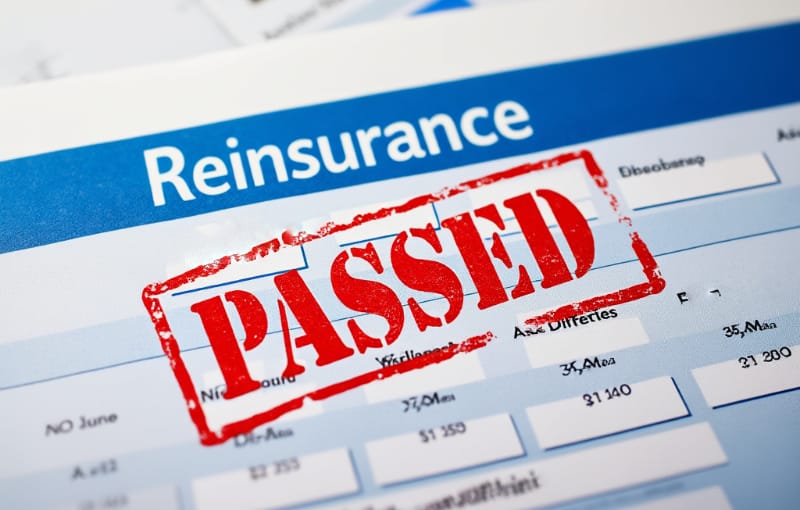Moody’s turns positive on reinsurance, with deepening alternative capital partnership

Rating agency Moody’s has shifted its outlook on the global reinsurance sector to positive citing the improvement in risk/return dynamics in the market and saying it anticipates continued strong profitability if major losses remain absent, while also saying property reinsurance rates are expected to remain elevated.
At the same time, the rating agency highlights the deepening partnership with alternative capital in the reinsurance industry, which despite growing has not become significantly more competitive with reinsurers.
Moody’s explained, “Higher prices and tighter policy terms, supported by favorable risk/return dynamics and healthy investment income support our positive outlook for the global reinsurance sector.
“Property reinsurers have raised the loss thresholds where reinsurance cover is triggered, and have reduced their exposure to high frequency, low-to-medium severity natural catastrophes such as severe convective storms.
“With only limited new capital entering the market, this will drive continued strong profitability over the next year, assuming no large catastrophes. We expect property reinsurance pricing to remain favorable.”
While price increases are expected to slow, Moody’s does not appear to expect significant softening or movements in terms and conditions.
Capital inflows are still not significant or expected to derail the market environment at this stage and in fact most capital coming into the market has had a complementary or partnership use-case, rather than a competitive one, Moody’s latest reinsurance report suggests.
Over the near to medium term, Moody’s explains that it anticipates “continued robust reinsurance sector profit” which bodes well for allocators to the sector.
“Overall, we expect conditions to remain favorable for reinsurers for at least the next 12 to 18 months. The industry has reassessed the risks it underwrites amid growing uncertainty over claims costs, and this will support prices. At the same time, higher prices have so far attracted only limited new capital, which will keep competitive pressure in check,” Moody’s explains.
The reinsurance market has seen limited new capital, Moody’s notes, with catastrophe bonds one area that has seen some flows this year.
But, as Moody’s explains, these are instruments that play a key protection role for insurers and reinsurers, so are not in direct competition and cat bond market growth represents an example of the deepening partnership with alternative capital.
“The impact of catastrophe bonds on broader market pricing has therefore been limited,” Moody’s said.
“In contrast to past cycles, rising prices have not triggered increased competition from new entrants and alternative capital providers,” Moody’s also said.
In addition, reinsurers use alternative capital to help in managing their probable maximum losses (PMLs), while insurance-linked securities (ILS) such as cat bonds also enable reinsurers to be more selective in which peak exposures they retain.
“Alternative capital, particularly catastrophe bonds, has been a significant source of capital enhancement for reinsurers,” Moody’s says, a term we particularly like as “enhancing” the balance-sheet capital of traditional insurers and reinsurers is the real benefit of having access to the capital markets.
A further deepening of the alternative capital relationship comes with the growing number of and expansion of reinsurers own dedicated third-party capital and ILS fund management platforms.
“A number of reinsurers have also successfully grown their alternative capital management platforms, including insurance linked securities (ILS) fund management arms. These platforms provide a steady source of third party capital to supplement the reinsurers’ own balance sheet capacity, reducing underwriting risk while also providing lower risk fee income,” Moody’s explained.
However, Moody’s also notes that dependence on alternative capital does not come without risk, especially were there to be really significant catastrophe events.
“A severe Florida hurricane could erode a high share of this capital and discourage investors from replenishing it. In this scenario, reinsurers with high reliance on catastrophe bonds and other forms of alternative capital would likely need to reduce their capacity for Florida hurricanes, or raise additional on balance sheet capital,” Moody’s noted.
One other insight from Moody’s latest report worth highlighting, is the rating agencies highlighting of the issue of unequal access to date in the market chain.
Speaking about an “uncertainty gap” that can drive risk perception and pricing higher in re/insurance, Moody’s says, “This has led to an increase in insurance premiums that is unlikely to reverse as long as the gap between estimated and actual cost of risk persists.”
Adding, “Higher premiums also reflect primary insurers, reinsurers and alternative capital providers’ unequal access to exposure data. Access to this data deteriorates the further the risk taker is from the underlying exposure. For example, alternative capital providers and to a lesser extent traditional reinsurers often have more limited data than primary insurers about the exact location, condition and type of properties in an insured portfolio. This makes it more difficult for them to accurately assess and price the risk.”
Improving the granularity, availability and flow of exposure and risk data along the market chain is a significant win for all parties, as it can aid in efficiency of risk transfer, reduce capital costs and make protection and hedging more affordable.
Of course, these benefits flow both ways, as the protection seller will also gain from commensurate improvements in data availability and transparency, with an ability to generate better returns, be more competitive on price and deploy capital more predictably.
Removing barriers such as unequal data access and sharing would not only benefit both sides of the reinsurance trade, it would also serve to encourage more capital entry, more efficient use of capital and ultimately foster deeper ties between traditional and alternative we believe, allowing for more effective use of these partnerships.
Moody’s report is a glowing review of the profit potential of reinsurance, underscoring the still strong opportunity to deploy capital to the sector.
Also read: The alternative capital partnership matures. But what about the reinsurance cycle?






